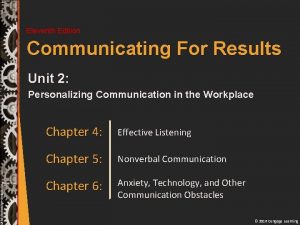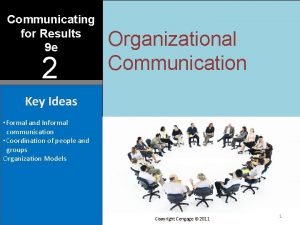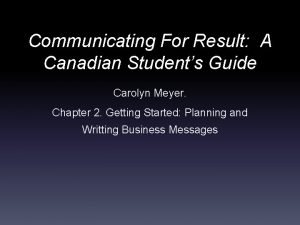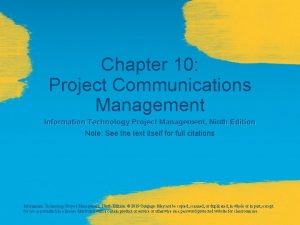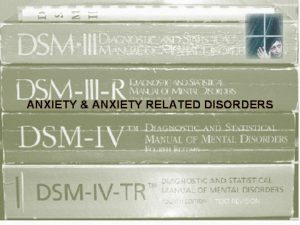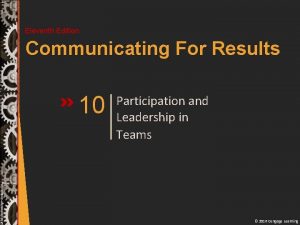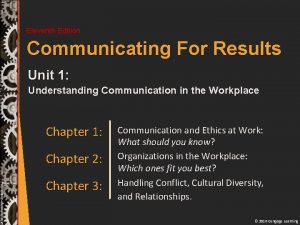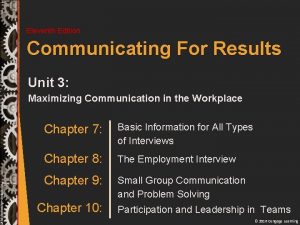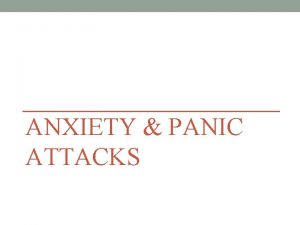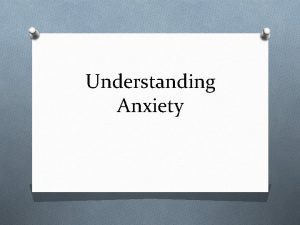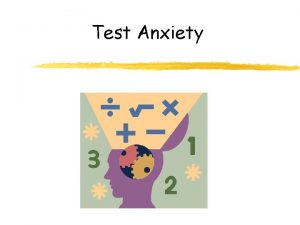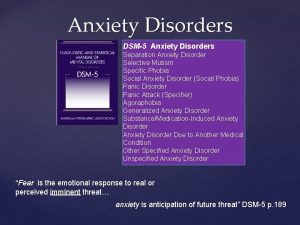Eleventh Edition Communicating For Results 6 Anxiety Technology





































- Slides: 37

Eleventh Edition Communicating For Results 6 Anxiety, Technology, and Other Communication Obstacles © 2016 Cengage Learning

Le. Messurier: Real-Life Case “An Engineer’s Experience” q Review the real-life case. q Answer the questions for Ch. 6 (pg. 104): – Which type anxiety probably gave Le. Messurier the most trouble? – Did technology work for or against him? What if today’s social media existed then? – What role did other obstacles like poor instructions play? © 2016 Cengage Learning

6 Really? Communication barriers are like roadblocks—they bring communication to a complete halt. Communication obstacles are more like potholes: they can cause uncomfortable bumps and jars, but with patience and training, you can learn to avoid them. Chapter 6. © 2016 Cengage Learning

Pr e : w vie Obstacles to Communication Covered in this chapter. . . q Communicator anxiety q Communication technology q Vague instructions q Jumping to conclusions q Bypassing q Sexual harassment © Phil Boorman/Age. Fotostock © 2016 Cengage Learning

Anxiety as a Communication Obstacle © Phil Boorman/Age. Fotostock © 2016 Cengage Learning

People With High Anxiety. . . What else can you add to this list? q Are perceived as less competent q Are less likely to be offered an interview q Make poorer impressions in interviews q Hold lower status & lower-paying jobs q Experience less job satisfaction Jan Schenders/Tetra images/Jupiter images © Phil Boorman/Age. Fotostock © 2016 Cengage Learning

What Causes Anxiety? An interaction of several factors. . . q Lack of preparation‒#1 cause q New or different situations q Negative experiences q Genetic endowment (communibiology) Jan Schenders/Tetra images/Jupiter images © Phil Boorman/Age. Fotostock © 2016 Cengage Learning

Types of Anxiety Types include. . . q Situational – anxiety caused by factors present in a specific speaking situation. q Trait – internal anxieties an individual brings to the speaking situation. Phovoir/Shutterstock. com © Phil Boorman/Age. Fotostock © 2016 Cengage Learning

Managing Situational Anxiety q Prepare and practice! q Warm up q Use deep breathing q Use a relaxing introduction q Concentrate on meaning q Use visual aids q Use positive imagery © Phil Boorman/Age. Fotostock © 2016 Cengage Learning

Did You Know? “ The only difference between the pros and the novices is that the pros have trained their butterflies to fly in formation. ” Edward R. Murrow © Phil Boorman/Age. Fotostock © 2016 Cengage Learning

Managing Trait Anxiety q Use positive imagery or visualization> q q q © Annie Dowie © Phil Boorman/Age. Fotostock © 2016 Cengage Learning

Positive Imagery Defined For speaker anxiety. . . “Creating a positive, vivid & detailed mental image of yourself confidently. . . (giving a successful presentation/or performing/or competing). ” © Phil Boorman/Age. Fotostock © 2016 Cengage Learning

We act as the person we “see” ourselves to be. © Phil Boorman/Age. Fotostock © 2016 Cengage Learning

Visualization Key Words (say it) + Vivid Mental Pictures (see it) + Feelings (feel it) = Confidence © Phil Boorman/Age. Fotostock © 2016 Cengage Learning

Three Steps to Positive Imagery q Step One: Prepare q(1) Look into future 2 or 3 months. (2) Picture self as speaker you want to be. q(3) Select characteristics needing work (such as enjoying speaking, good volume, or gestures). © Phil Boorman/Age. Fotostock © 2016 Cengage Learning

Three Steps to Positive Imagery q Step One: Prepare q Step Two: Write statements (1) Use characteristics to write five to ten positive statements—“My delivery is dynamic and enthusiastic while speaking. ” q (2) Avoid words like will, want, or hope—make statements sound like they are already true: –Weak: “I hope I will use good gestures” –Strong: “When I speak, my gestures are natural and relaxed. ” © Phil Boorman/Age. Fotostock © 2016 Cengage Learning

Three Steps to Positive Imagery q Step One: Prepare q Step Two: Write statements q Step Three: Read, visualize, and feel –Read statements twice a day for 4 weeks. –As you read, visualize with detail & clarity. –As you read, feel confident as well. –Say, see, and feel is the key to confidence. –See pages 167 168 for more details. © Phil Boorman/Age. Fotostock © 2016 Cengage Learning

Sample Positive Statements q I feel as relaxed and confident giving a formal speech as I do entertaining good friends in my own living room. q I enjoy giving presentations regardless of the size of the audience. q I am a warm, relaxed, and entertaining speaker. q When I’m in front of a group, words flow easily for me. q People respond well to my presentations. q Anxiety, which is a form of excitement, is a good thing because it gives me extra energy and power as a speaker. © Phil Boorman/Age. Fotostock © 2016 Cengage Learning

Managing Trait Anxiety (cont. ) q Use positive imagery or visualization q Use your imagination q See yourself as speaker you want to be q Picture yourself being successful q Remember: Words + vivid mental pictures + feelings = confidence q Read a positive imagery exercise (or write your own, pg. 168) © Annie Dowie © Phil Boorman/Age. Fotostock © 2016 Cengage Learning

Other Anxiety Reduction Methods To train your butterflies, try one of the following (Table 6. 1): q Relaxation with deep breathing q Cognitive restructuring of self-talk q Skills training (like this course). . . “the widest possible combination of methods” is often the most effective in reducing apprehension (Bodie, 2010, p. 91). © Phil Boorman/Age. Fotostock © 2016 Cengage Learning

Technology as a Communication Obstacle © Phil Boorman/Age. Fotostock © 2016 Cengage Learning

6 Polishing Career Skills Do you leverage the power of social media? How ready are you to leverage the power of social media? Find out by taking this survey : 1 = NA 2= No 3= No, but I will soon 4= partially done 5= completely done 1. I have read 10 15 profiles in my field to see what makes them either good or not so good and will use this information to write my profile. 2. I have a powerful Linked. In profile. 1 3. I have researched for keywords used in my field of study and added them 1 to my profile. 4. I update my profile every two months to keep it current for search engines. 1 5. I have joined a “group” on Linked. In and made sure that my posts show me as an interested and valuable person to know. 6. I have received some good “recommendations” on Linked. In. 1 7. I have added a quality head-and-shoulder photo to my Linked. In profile. 1 8. I have added experiences and skills to my profile and given examples to 1 illustrate them when possible. 9. I have updated my resume and attached it to my Linked. In profile. 1 10. I update my resume every 2 months or even more often when job-hunting. 11. I have used my Linked. In (or other social media profile) to build a similar (but 1 not exact) profile on Google+ or Facebook. 12. I have looked carefully at my pictures and posts on Facebook and Twitter and have removed any that do not support me as a quality job candidate. 1 2 3 4 5 2 3 4 5 2 3 4 5 1 2 3 4 5 Total your scores and see p. 178 for assessment instructions. © 2016 Cengage Learning

Ask Yourself Three Questions To keep social media from becoming an obstacle. . . q If I were an employer, how would I react to posts on my social media sites? q What should I remove, if anything? q Why do employers care so much about what I post on social media? See page 172 for what to remove from your social media sites. © Phil Boorman/Age. Fotostock © 2016 Cengage Learning

Contacts into Relationships? Ques: Why and how can you use social media to make contacts into relationships? (See pg. 173) © Phil Boorman/Age. Fotostock © 2016 Cengage Learning

Social Media Resume? Ques: How do you make your resume stand out from the millions of profiles and resumes on social media? (Pg. 174) © Phil Boorman/Age. Fotostock © 2016 Cengage Learning

Building a Linked. In Profile? Five ways to build a dynamic and searchable profile (pg. 175 -6). . . q q q Begin with a clear position or title Add quality photo—a head-and-shoulder shot. Add work experience and skills. Use “real-sounding” language (not jargon). Write summary in the first person—show your personality. Profiles with a good photo are 11 times more likely to be clicked on and read (See Linked. In Activity, pg. 192). © Phil Boorman/Age. Fotostock © 2016 Cengage Learning

Disadvantages to E-mail Disadvantages to e-mail , IM, & Blogs. . . q It is legal for employers to inspect employee e-mail q Senders seldom proofread for content or tone q People respond to e-mail, IM’s, & blogs even when uncertain or angry q Since e-mail can be read multiple times, its “tone” is critical. © Phil Boorman/Age. Fotostock © 2016 Cengage Learning

Videoconferencing Characteristics of electronic meetings. . . q Less emotion and conflict q Participation more organized q Decision-making equal to face-to-face q Participation more equal q Less satisfying than face-to-face © Phil Boorman/Age. Fotostock © 2016 Cengage Learning

Other Communication Obstacles © Phil Boorman/Age. Fotostock © 2016 Cengage Learning

Vague Instructions For clear instructions, follow these rules. . . q q q q Begin with overall picture Use minimum words Use good delivery techniques Make words specific & easy to understand Number or “signpost” objects/steps Use simple comparisons Use repetition End with summary Give instructions to draw these objects; See p. 182 in book. © Phil Boorman/Age. Fotostock © 2016 Cengage Learning

6 Awareness Check Jumping to Conclusions. . . STORY: J. R. Ramos is V. P. of Development at an international game-development company. A Skype meeting with four of J. R. ’s managers revealed a serious scheduling problem at the Taiwan manufacturing plant. Nguyen is dispatched with a translator to “assist” Barkley who is on site. One manager was tasked with monitoring the work and reporting daily to J. R. STATEMENTS ___ 1. The manufacturing problem is in Vietnam. ___ 2. Nguyen was authorized to fire Barkley if appropriate. ___ 3. Barkley was part of the Skype meeting. ___ 4. Three managers are men. ___ 5. JR found out about the problem during a meeting. ___ 6. Barkley is in Taiwan. ___ 7. J. R. sent his manager to Taiwan. ___ 8. The person responsible for reporting daily to J. R. was a supervisor. ___ 9. The problem was related to scheduling. ___ 10. The company produces online games. ___ 11. Barkley is one of the managers. *Story from unknown source. Check page 185 for additional information; see answers in back of book. © 2016 Cengage Learning

6 Awareness Check Bypassing. . . Compare answers with classmates; see p. 187 © 2016 Cengage Learning

Sexual Harassment Defined “Unwelcome sexual advances, requests for sexual favors, and other verbal or physical conduct of a sexual nature constitutes sexual harassment when this conduct explicitly or implicitly ‒ affects an individual’s employment, ‒ unreasonably interferes with an individual’s work performance, or ‒ creates an intimidating, hostile, or offensive work environment. ” U. S. EECO, 2016 © Phil Boorman/Age. Fotostock © 2016 Cengage Learning

Sexual Harassment Concepts Previous definition includes two basic concepts. . . q Quid pro quo‒promise of rewards (promotion or perks) or threat (loss of job) q Hostile work environment‒when conditions are “intimidating, hostile, or offensive” (See p. 189 for discussion of Walmart’s problems with sexual harassment. ) © Phil Boorman/Age. Fotostock © 2016 Cengage Learning

Handling Sexual Harassment Which of these seem the most important? Difficult? q Review organizational policies q Project friendly but professional image q Confront harasser in assertive manner q State behavior, what is wrong, what you expect q Document incidents of harassment q Report incident to supervisor q Weigh consequences of further action © Phil Boorman/Age. Fotostock © 2016 Cengage Learning

For More Group Activities See pages 190 192 in your book. . . q Technology activity q Positive imagery & confidence activities q Self-nudging activity q Linked. In activity q Harassment activity q Unit II, real-life activity (review pg. 103) © Phil Boorman/Age. Fotostock © 2016 Cengage Learning

6 The End © 2016 Cengage Learning
 Communicating for results 11th edition
Communicating for results 11th edition Communicating for results 11th edition
Communicating for results 11th edition Management eleventh edition stephen p robbins
Management eleventh edition stephen p robbins Management eleventh edition stephen p robbins
Management eleventh edition stephen p robbins Management eleventh edition
Management eleventh edition Management eleventh edition stephen p robbins
Management eleventh edition stephen p robbins Silk glove sign
Silk glove sign Communicating for results a canadian student’s guide
Communicating for results a canadian student’s guide Bhore committee
Bhore committee Eleventh 5 year plan
Eleventh 5 year plan Thfive
Thfive For his eleventh birthday elvis presley
For his eleventh birthday elvis presley Using mis (10th edition) 10th edition
Using mis (10th edition) 10th edition Zulily case study
Zulily case study Information technology project management 9th edition
Information technology project management 9th edition Blue project chapter 5
Blue project chapter 5 Ethics in information technology 6th edition answers
Ethics in information technology 6th edition answers Automotive technology sixth edition
Automotive technology sixth edition Automotive technology sixth edition
Automotive technology sixth edition Ethics in information technology fourth edition
Ethics in information technology fourth edition Project management quality control
Project management quality control Information technology project management 9th edition
Information technology project management 9th edition Basic environmental technology 6th edition pdf
Basic environmental technology 6th edition pdf Information technology project management 9th edition
Information technology project management 9th edition Kontinuitetshantering
Kontinuitetshantering Typiska drag för en novell
Typiska drag för en novell Nationell inriktning för artificiell intelligens
Nationell inriktning för artificiell intelligens Ekologiskt fotavtryck
Ekologiskt fotavtryck Varför kallas perioden 1918-1939 för mellankrigstiden
Varför kallas perioden 1918-1939 för mellankrigstiden En lathund för arbete med kontinuitetshantering
En lathund för arbete med kontinuitetshantering Underlag för särskild löneskatt på pensionskostnader
Underlag för särskild löneskatt på pensionskostnader Tidbok för yrkesförare
Tidbok för yrkesförare Anatomi organ reproduksi
Anatomi organ reproduksi Densitet vatten
Densitet vatten Datorkunskap för nybörjare
Datorkunskap för nybörjare Tack för att ni lyssnade bild
Tack för att ni lyssnade bild Mall för debattartikel
Mall för debattartikel Autokratiskt ledarskap
Autokratiskt ledarskap
